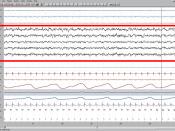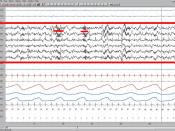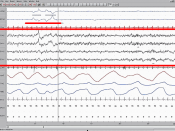Evaluate the characteristics of sleep and consider what evidence there is for an understanding of why we sleep.
Up until the 1950's the majority of researchers believed that 'sleep' was a resting state that was the exact opposite of being awake. It was not until 1953 that work by Kleitman and Aserinsky produced evidence that this was indeed not the case. Berger (1920) was the first researcher to use an electroencephalogram (EEG) to examine electrical brain activity during sleep. To understand the later theories of why we sleep it is important to understand the levels of brain activity that are present during sleep. Berger placed electrodes onto the scalp pick up the brain activity. Tiny voltages are detected as the neurone fire and the electrical signal is amplified thousands of times. The results of an EEG are displayed on a polygraph.
Berger was able to see that the results of the EEG produced more than a mess of lines from the neurones.
In fact he saw that the brain was very active and regular. The patterns produced were wave like and fairly regular. He identified two different patterns that were present during waking hours: - Beta waves; very common, irregular/desynchronised low amplitude waves (between 13 and 30 Hz or beats per seconds). Beta waves are seen in alert, wide-awake conscious people. Alpha waves are seen during periods of rest and deep relaxation. They are more synchronised 'high-amplitude' waves than beta waves. The brain during these waves slows down to 8-12 Hz.
Further study in this area of EEG activity Kleitman and Aserinsky showed that there were other types of waves that did not occur in the waking hours. They showed that there were two distinct EEG patterns that occurred during two completely different stages of sleep. These are...


